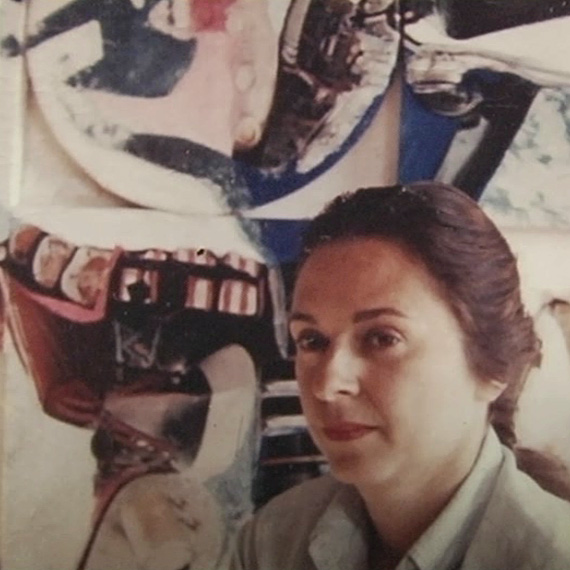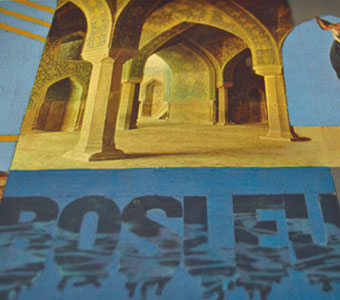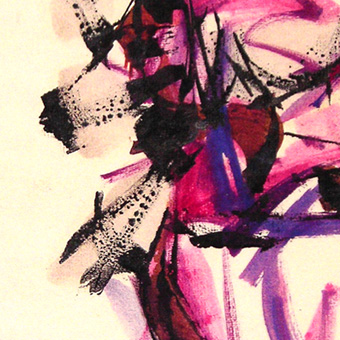











When I graduated from Cooper Union in l954, I received the Academic Honor Award and won a Fulbright Scholarship for study in Rome from 1954 to 1955, which was renewed in 1955 for another year. While I was in Italy, my work was included in the Pittsburgh International Exhibition of 1955. During my two-year stay in Europe, I travelled extensively in Italy, France, England, Spain, Greece, Yugoslavia, Turkey and Egypt. Living and working abroad was an enriching and maturing experience. It gave meaning and continuity to the past and new significance to the present.
In 1957, I moved to London, Ontario. The four years in Canada were extremely productive. I showed in many important national exhibitions and private galleries and won several prizes. Among these are: Baxter Foundation Award in Toronto, Honor Awards at the Winnipeg Show and the Vancouver Art Gallery, a Canadian Watercolour Society Award, and the Dow Award at the Montreal Spring show.
Although my work was abstract and I did not work directly from the scene, it was greatly influenced by the Canadian landscape and, as one critic put it, evoked "landscapes of the heart." My work could still be called abstract although over the years I have found inspiration in shell and flower forms as well as landscapes.
In 1974, I was commissioned to create a mural for the reading room of a new branch library in New York City. From 1968 to 1992, I was Adjunct Professor of Art at Pratt Institute. During a sabbatical year (1988-89), I worked on monoprints, a new medium for me. At present I am combining various techniques I had explored individually in the past, and this gives a new dimension to my work.

My works are not meant to be translations from one language into another, but rather direct experiences, which are different from other kinds of experience both for the viewer and for me. When the work is successful, it can evoke images, feelings, memories and ideas which one may try to describe in words but which in the end remain largely ineffable.
My aim is to create beauty on a two dimensional plane with all or any of the means at my disposal. This beauty is not necessariy related to anything which already exists in the external world, although it may be inspired by such things as landscapes, plants, flowers, shells, lights, buildings - a myriad of things.
These shapes and colors are a starting point to help me create the art, which is a thing in itself. It tells no story, reproduces no object. It may evoke as many different responses as there are individuals who view it.

Then I proceeded to draw on the arbitrary rectangular composition with colored pencils, an unusual combination. These compositions wandered over the line surfaces sometimes respecting the rectangles and sometimes ignoring their edges. This back and forth play intrigued me. The imagery was evoked by the shell forms and patterns which had been the inspiration for my oils for a long time. The next phase was to glue rice paper onto the canvas rectangles upon which I use a combination or combinations of colored pencil, pastel, watercolor and paint.
In looking over my work, which spans a long period of time, I find that I have been drawn to similar forms, shapes, colors and textures, always coming from nature - landscapes, flowers, shells. Sometimes they are seen very close up, sometimes in what may seem like an aerial view. When forms are isolated, scrutinized, enlarged, similarities begin to emerge; the regular repetition of flower petals can find echoes in the pattern on a shell, or vice versa. These are the things that have attracted me both consciously and unconsciously.

This is a group of paintings which were done in New York since I left London exactly three years ago. They represent two different periods. The first group of non-objective paintings are the culminating expressions of my years in London as recollected and re-experienced in New York. The evocative landscape quality which dominated my London work is still a basic element here but there has been a change. Now there is a complexity and a dark, powerful, surging movement which the city has invoked.

These experiments led me back to using images, first non-objective ones as before, and then actual images in a non-objective manner. For the most part I have used these photographs as abstract colors, shapes, lines and textures. In combining them with areas of paint I discovered that the two elements seemed to transform one another to become a third new element.
I have been interested in using non-rectangular shapes because they have the contrasting qualities of suggesting a larger world while at the same time offering fragments of that world. It is exciting and challenging to explore these new ideas and to follow where they will lead me.


At the beginning color and design will be approached separately in a series of simple but profound and basic problems which will lay the foundations for the more advanced work we will soon be doing. These problems were designed to help clarify and simplify and intensify your experiences and knowledge so that you can use this understanding as a basic vocabulary of skills and techniques.
Back to top